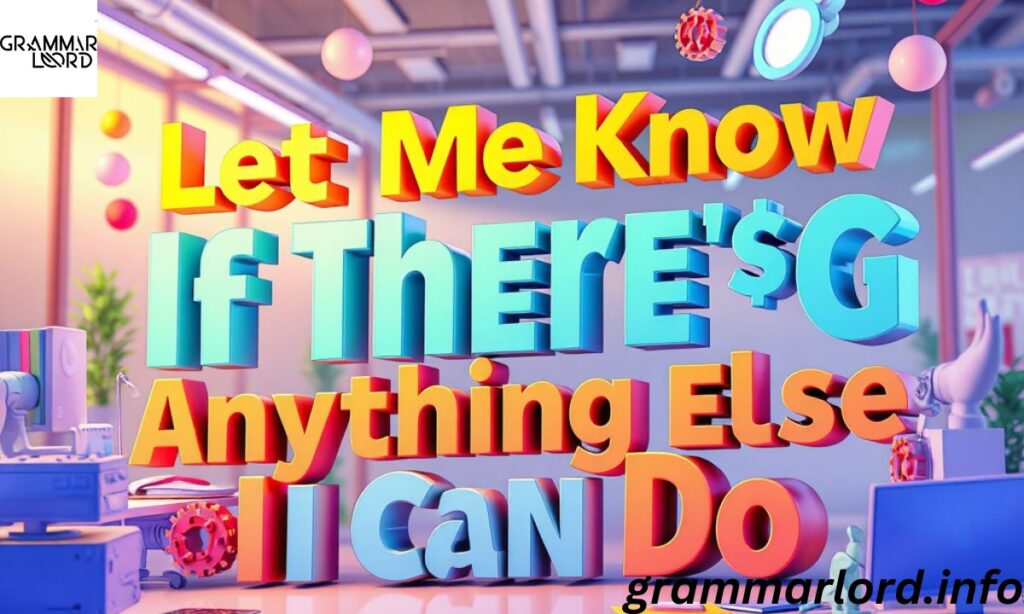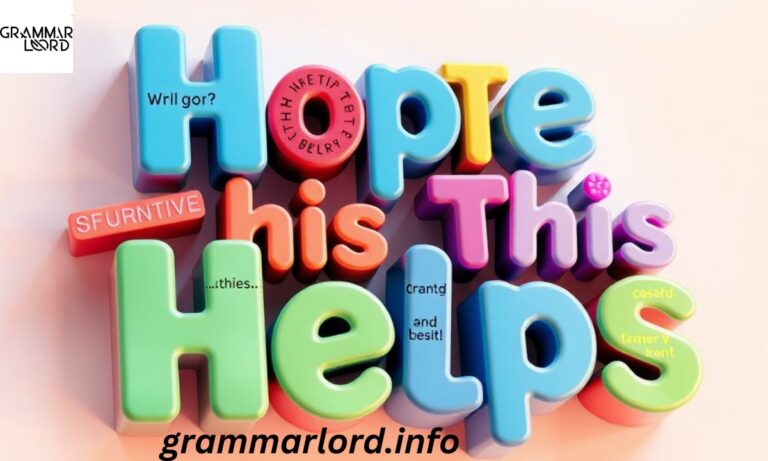Sometimes, we want to check if our advice or information is useful, but saying “Hope this helps” all the time can feel repetitive. There are many other ways to express the same idea while sounding more natural and thoughtful.
Choosing the right phrase depends on the situation and the tone you want to set. Some options sound professional, while others feel more friendly and casual. Using variety in our language makes communication clearer and more engaging.
Main Points
- Variety in Communication – Using different phrases keeps conversations fresh and engaging.
- Professional vs. Casual Tone – Some alternatives sound formal, while others are more friendly.
- Clarity and Understanding – Choosing the right words ensures the message is clear.
- Encouraging Feedback – Many alternatives invite further questions or discussions.
- Offering Support – These phrases show a willingness to help beyond just one response.
- Building Trust – Thoughtful language makes interactions more positive and supportive.
- Tailoring to the Situation – Different situations require different levels of formality.
- Avoiding Repetition – Using varied expressions prevents messages from sounding robotic.
- Keeping Conversations Open – Many alternatives encourage ongoing dialogue.
- Enhancing Professionalism – In business settings, choosing the right phrase improves communication.
I Hope This Is Useful
When providing information, it’s important to ensure that the recipient finds value in it. Whether it’s advice, instructions, or suggestions, making sure that what you share is relevant and practical is key. Being clear and concise helps the reader or listener absorb the information effectively.
It’s also helpful to provide examples or real-world applications. When people find something useful, they are more likely to apply it in their own situations. Offering additional resources can further enhance their understanding.
It’s always a good idea to check if the information is aligned with their needs. A well-organized response can make all the difference. Encouraging feedback can help improve future communication. Ultimately, the goal is to make a positive impact. Hopefully, this message serves that purpose.
Let Me Know If This Helps

Communication is a two-way process, and feedback plays a crucial role in it. When offering guidance, it’s always beneficial to check if the other person finds it helpful. Sometimes, what seems clear to one person might not be as understandable to another.
Encouraging them to ask questions ensures clarity. This phrase creates an open-door policy for further discussion. It also reassures the recipient that their understanding matters. A simple follow-up question can provide deeper insights into their concerns.
If something isn’t working for them, adjustments can be made accordingly. Offering assistance beyond the initial response builds trust. People appreciate it when their needs are genuinely considered. Keeping communication open makes problem-solving more effective.
I Hope This Clarifies Things
Misunderstandings can often arise in conversations, whether written or spoken. Clarifying information helps avoid confusion and ensures accuracy. Providing clear explanations allows the recipient to grasp the intended message.
Using simple language instead of jargon can make a significant difference. Breaking complex ideas into smaller parts can enhance comprehension. Examples and analogies can also aid in making concepts more relatable.
Sometimes, a different perspective is all that’s needed for better understanding. Checking in with the recipient can confirm whether they now feel more informed. It’s important to be patient while explaining things. A well-clarified message leads to smoother communication and better outcomes.
I Hope This Provides Some Insight
Gaining insight into a topic requires both information and perspective. When sharing knowledge, it’s beneficial to present different angles. Sometimes, looking at a situation from a new viewpoint can lead to better decision-making.
Encouraging curiosity helps in developing a deeper understanding. Insightful information often comes from experience, research, or expert opinions. Thoughtful analysis can reveal hidden patterns and connections. Providing context to the information makes it easier to relate to.
When people gain insights, they can make informed choices. Offering practical applications enhances the value of shared knowledge. The goal is to leave the recipient with a clearer and more comprehensive understanding.
I Trust This Will Be Helpful
Trust plays an essential role in communication and knowledge sharing. When offering assistance, it’s important to believe in the value of the information being provided. This phrase conveys confidence in the guidance given.
It also reassures the recipient that effort was put into making the response helpful. Being thorough and thoughtful in explanations increases the likelihood of usefulness. Checking the accuracy of information ensures credibility.
Encouraging further questions fosters a supportive environment. People appreciate responses that are well-researched and considerate. When someone trusts the information given, they are more likely to act on it. Trust strengthens relationships and enhances meaningful exchanges.
I Hope This Answers Your Question
When people seek information, they often have specific concerns in mind. Ensuring that their questions are fully answered is essential. A well-structured response directly addresses the query without unnecessary details.
If clarification is needed, breaking the answer into key points can be effective. Anticipating follow-up questions can enhance the completeness of the response. Providing examples and references makes the answer more credible.
Encouraging feedback helps confirm whether the explanation is satisfactory. If the answer isn’t clear enough, offering additional resources can be beneficial. Good communication focuses on meeting the needs of the person asking. The goal is to provide clarity and confidence in the response.
Let Me Know If You Need More Details
Sometimes, a brief response isn’t enough to fully address a topic. Encouraging the recipient to ask for additional details promotes open communication. It reassures them that their understanding is a priority.
Some situations require more in-depth explanations or supporting information. Offering to elaborate shows a willingness to assist further. People often hesitate to ask for clarification, so this phrase helps ease that hesitation.
Providing examples, statistics, or sources can strengthen the information given. A well-supported response ensures that the recipient has everything they need. Encouraging further discussion can lead to a more meaningful exchange.
I Hope This Makes Things Clearer
Clarity is essential in any form of communication. Without it, misunderstandings and confusion can arise. Ensuring that information is presented in a straightforward manner helps the recipient grasp the message.
Using simple and concise language can be more effective than overly complex explanations. Structuring the response logically enhances readability. Visual aids, such as charts or diagrams, can also improve comprehension.
Checking whether the recipient understands ensures the message is received correctly. Offering additional clarification if needed makes communication smoother. A clear message leads to more effective decision-making. The goal is always to simplify rather than complicate information.
I’m Happy to Help If Needed
Offering assistance creates a positive and supportive environment. This phrase reassures the recipient that they are not alone in finding a solution. It encourages them to reach out if they need further guidance.
Sometimes, people hesitate to ask for help, so a friendly tone can make them feel more comfortable. Providing support builds stronger relationships and trust. It also demonstrates a willingness to go the extra mile.
Being approachable makes it easier for others to seek assistance. Good communication is about being available when needed. Helping others not only benefits them but also fosters a sense of teamwork. The goal is to ensure that everyone has the support they require.
I Hope This Gives You What You Need
When providing information, it’s important to ensure it meets the recipient’s expectations. People seek guidance for different reasons, whether for decision-making, problem-solving, or learning. A well-crafted response should align with their needs.
If something is missing, offering additional resources can be beneficial. Being specific in answers helps avoid ambiguity. A personalized response increases the likelihood of it being useful.
Encouraging feedback ensures that the information provided is adequate. Providing multiple options can help them choose what works best. The goal is to ensure they walk away feeling informed. A well-thought-out response makes a meaningful impact.
Let Me Know If You Need Further Assistance
Sometimes, an initial explanation isn’t enough to fully address an issue. Encouraging further discussion allows for better clarity. It reassures the recipient that they can seek more help if needed.
Some questions require deeper analysis and follow-up responses. Providing ongoing support ensures a smoother resolution to any concerns. People appreciate knowing they have access to additional guidance.
This phrase fosters an open and helpful communication style. Offering different ways to reach out can make assistance more accessible. A problem-solving approach often requires multiple interactions. The goal is to ensure they feel fully supported.
Hope This Information Is Helpful
Sharing knowledge is valuable only when it serves its intended purpose. Ensuring that the recipient benefits from the information provided is important. A well-organized response enhances comprehension and usability.
If something isn’t clear, offering further clarification can help. Encouraging dialogue fosters a collaborative exchange of ideas. It’s beneficial to check whether the provided information meets their expectations.
Practical applications make information more relevant. Keeping communication open allows for improvements. A helpful response builds trust and reliability. Ultimately, the aim is to make a positive difference with the information shared.
I Hope This Points You in the Right Direction
When guiding someone, the goal is to provide direction rather than just information. Offering a clear path forward ensures they feel more confident in their next steps. Sometimes, a little guidance is all that’s needed to make progress.
Recommending helpful resources can add further value. If they need more details, encouraging follow-up questions is essential. People appreciate knowing they are on the right track.
A well-thought-out response should align with their goals. Supporting them in their journey fosters trust. Providing insights that lead to solutions is highly beneficial. The ultimate aim is to empower them with useful knowledge.
Let Me Know If There’s Anything Else I Can Do

Offering continued support is an essential part of good communication. This phrase reassures the recipient that help is still available. It encourages them to ask for any additional assistance they might need.
People often hesitate to seek further clarification, so an open-ended invitation can be comforting. Providing support fosters positive and productive interactions. Being approachable makes communication more effective.
Ensuring that all concerns are addressed builds trust. Encouraging further dialogue leads to better understanding. Showing genuine willingness to help makes a lasting impact. The goal is to create a supportive and helpful exchange.
Frequently Asked Questions
Why should I use different ways to say “Hope this helps”?
Using different phrases keeps communication fresh, engaging, and suited to different situations.
Which alternative phrases are best for professional emails?
Phrases like “I trust this will be helpful” or “Let me know if you need further assistance” sound more professional.
Are these phrases suitable for casual conversations?
Yes! Options like “I hope this gives you what you need” or “Let me know if this helps” work well in informal chats.
How do I choose the right phrase?
Consider the tone of the conversation, your relationship with the recipient, and the level of formality needed.
Can I use these phrases in customer service responses?
Absolutely! Alternatives like “I hope this clarifies things” and “Please let me know if you need more details” show helpfulness and professionalism.
Conclusion
Effective communication is about more than just sharing information—it’s about making sure the message is clear, helpful, and suited to the situation. Instead of always using “Hope this helps,” trying different phrases can make conversations feel more natural and engaging. Whether you’re writing an email, responding to a question, or offering support, choosing the right words makes a difference.
By using a variety of phrases, you can sound more professional, approachable, and thoughtful. These alternatives also encourage open conversations and show that you genuinely care about the recipient’s needs. The next time you want to offer help, try using one of these 14 different ways to say “Hope this helps” and make your communication more effective.

